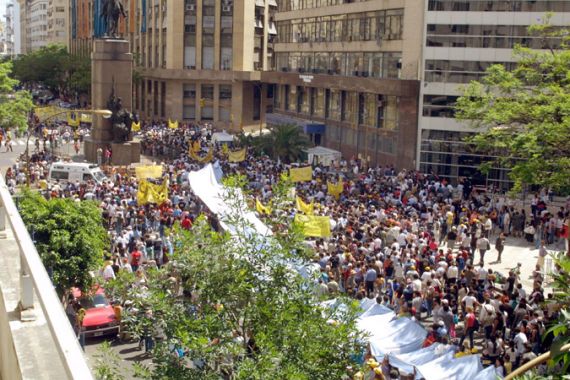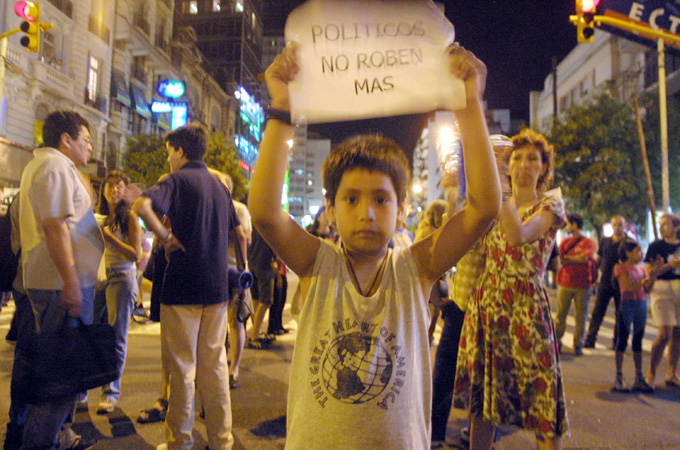Is it time to occupy the highways?
‘Occupy’ protesters might want to look at the case of Argentina, where activists used roadblocks as a successful tactic.

 |
| Argentinians have effectively used roadblocks as part of protest movements [GALLO/GETTY] |
Now that billionaire New York City Mayor Mike Bloomberg has evicted protesters from their encampment in Liberty Plaza, some are wondering what the future might hold for the “Occupy” movement. Without their strategic base near Wall Street, activists might find it more difficult to coordinate demonstrations in the vicinity. On the other hand, if Bloomberg and the financial elite hoped that the NYPD’s preemptive move on Occupy would eviscerate political protest, then they will probably be disappointed. If anything, the authorities have merely succeeded in dispersing demonstrations which could wind up proving even more difficult to contain.
As Occupy now moves to “phase two” in its evolution, protesters might want to weigh the various advantages and disadvantages of street demonstrations and even roadblocks. It is here where the case of South America might prove instructive. For years, indigenous peoples in the Andes have employed road blocks as an innovative tactical weapon in pressing for popular demands. One thing’s for sure: Roadblocks get you noticed. As traffic piles up, trucks can’t move and companies are unable to get supplies in. That in turn pinches agribusiness, which can’t move its grain. Before long, the day of reckoning approaches for the financial elite, whose profits get squeezed.
From Argentina to OWS
In no other country have activists perfected the concept of the strategic roadblock more effectively than in Argentina. There, virtual armies of unemployed called “piqueteros” have been able to disrupt commerce and thereby exert significant political pressure on the central government. With their calls for everything from food parcels, state-funded jobs, living wages, unemployment benefits and public investments in water, electricity, paved roads and health facilities, in addition to the release of incarcerated militants and withdrawal of police, the piqueteros have succeeded in shifting the political discussion in Argentina.
Even before Bloomberg evicted protesters from Liberty Plaza, demonstrators seemed to be taking an increasingly Argentine tack. Recently, a small group of occupiers left New York en route to Washington, DC so as to draw attention to a meeting of the so-called Congressional Supercommittee charged with settling the rancorous debate over US debt. The occupiers wished to send a succinct message to Congress: Eliminate the Bush tax cuts for the rich in order to help balance the budget and save severely needed social programmes.
It would be a stretch to say that “occupy the highway” approaches the same level of radical tactics as the Argentine roadblocks, yet perhaps this walk is a harbinger of things to come. A kind of experiment in mini-democracy, the march featured so-called “General Assemblies” held in local towns along the route. The activists, who were funded by the original encampment at Liberty Plaza to the tune of $3,000, made the arduous 300-mile trek to DC on foot, no less, passing through the New Jersey town of New Brunswick along the way. There, activists met up with Rutgers University students, and the two groups took over a roadway alongside a local bridge. As downtown traffic was brought to a standstill, pedestrians curiously looked on.
The piquetero movement
Like Occupy, which was a product of the 2008 financial collapse and ensuing dislocation, the piquetero movement also grew as a response to economic mismanagement at the top. Starting in the late 1980s, Argentina began to lower tariffs and to privatise state enterprises, resulting in job losses. Not only did the government fail to spur new employment, but the authorities scaled back the nation’s welfare system. In 1997, Argentina spiralled into recession.
After pleading for the labour unions to come to their aid, petitioning the government and carrying out peaceful protests, all without result, the unemployed resorted to a new tactic: roadblocks. Taken off-guard, the government responded with violence and troops cracked down with bullets and tear gas. Nevertheless, when the piqueteros refused to back down, authorities in the northern province of Jujuy eventually caved by agreeing to create more than 12,000 jobs and increase unemployment assistance.
It was not long before the piquetero movement spread from the north to other industrial cities, including Buenos Aires. Motorists, who were accustomed to speeding past the homes of the poor and destitute on the highway, were now forced to contend with combative protesters who set fire to tyres and halted traffic. Pushing the envelope of social protest, piqueteros set up tents and soup kitchens alongside roadblocks, thus attracting hundreds and even thousands of people. During the pickets, individual members would take care of security, raise funds and ask local merchants to donate food.
Creating a ‘counter-power’
If activists in the US seek to intensify political and social struggle, they might want to study and reflect upon the Argentine experience. Piqueteros insisted on participatory decision-making, organising themselves at the neighbourhood and municipal level. In some parts of the country, piquetero struggle essentially rendered local officials powerless and created quasi-liberated areas and a virtual “counter power” to the government. Unemployed workers created a virtual “parallel economy” in certain zones with their own clothing banks, bakeries, publishing concerns, libraries, community kitchens, kindergartens, organic gardens, water purifying plants and even, first-aid clinics providing vaccinations.
Such innovative tactics had little to do with the cautious and staid approach of Argentine labour. Like the mainstream rank-and-file in the US, which has been slow to improvise or offer creative solutions to the nation’s political impasse, Argentina’s labour unions had become somewhat irrelevant by the time of the economic crisis. Some union bosses even collaborated with the corrupt political establishment, while others negotiated behind workers’ backs. Accustomed to their perks and privileges, union officials were reluctant to make their way through muddy shantytowns to organise the unemployed.
Radicalisation of Argentine society
To be sure, roadblocks are highly dangerous and can be frightening for all those concerned. They can also disrupt the daily business of commuters and anger the population at large. One can debate whether the publicity gained by certain pickets was outweighed by the public backlash from motorists, some of whom went so far as to try to run over demonstrators.
Countering their critics, the piqueteros argued that the right to eat and proper shelter ought to take precedence over the right to drive freely.
The piqueteros also demanded that negotiations with the government occur at the actual site of blockades so that all protesters could participate. While such a strategy might appear paranoid, experience had shown the piqueteros that conducting private negotiations in government offices downtown encouraged corruption. More often than not, the authorities would award jobs to those individuals directly involved in the deal while cutting others out of the picture.
Things took a decided turn for the worse, however, when in 2002 police killed two piqueteros who had blocked an access bridge in Buenos Aires. The unfortunate victims quickly became martyrs, and the incident proved so politically damaging to the government of then President Eduardo Duhalde that the latter felt compelled to call elections. His successors, including Argentina’s power couple Néstor and Cristina Fernández de Kirchner, pursued a wary and cautious policy towards the piqueteros.
Achieving real results
At a certain point, the protesters commanded so much sympathy that the federal police could do little but passively stand by as roadblocks unfolded. That is not too surprising when you consider that the recession had become a full-blown depression by 2001-02, with 54 per cent of the Argentine population falling below the poverty line. Concerned about growing radicalisation, the authorities belatedly started to address Argentina’s social ills, and under the Duhalde regime, the government outsourced the administration of part of its emergency welfare scheme to piquetero leaders themselves.
In 2002, the authorities also started to provide a small stipend to unemployed heads of households. In some cases, the payments were distributed through the piquetero organisations themselves, which decided who was eligible, what community services members had to engage in as part of the workfare scheme, and what share of the money individuals should share with the larger group.
Psychologically, the piqueteros had begun to change Argentina’s political culture. It was not long before all sectors of society started to participate in pickets, with demands ranging from everything to new bridges to more welfare and lower agriculture export taxes. Feeling the political heat, both Kirchners moved to mollify the disenfranchised. In 2005, Néstor Kirchner expanded relief efforts by creating a Families Plan, which provided payments to hundreds of thousands of poor mothers, while Cristina later launched “Argentina Trabaja” (Argentina Works), a $2.4bn plan to create 100,000 jobs in community work co-operatives.
Occupy highway
As they reflect upon recent Argentine political history, occupiers might wonder whether the time has come to emulate combative South American tactics. As the Argentina case shows, radical protest can shift the political discussion in fundamental ways and even achieve concrete gains. On the other hand, as “Occupy Highway” recently demonstrated, some members of the public are unreceptive to the cause of economic justice: Passing through Trenton, New Jersey, the occupiers were subjected to hecklers and jeering. Since this particular action was rather minor in scale, one can only imagine that more confrontational roadblocks would result in an even greater backlash from the authorities and media.
There is reason to believe that pickets could backfire among the public too, since unemployment and poverty, though certainly severe in the US, have not yet reached epidemic proportions as in Argentina. In addition, there are real reasons to doubt the long-term efficacy of roadblocks. While the piqueteros played a vital role in their day, the movement has not demonstrated staying power, and once Argentina’s economy improved, roadblocks calmed down. With the loss of vital middle-class support, it’s unlikely that the piqueteros will be able to regain mass momentum any time soon.
All of this is not to say that pickets should be categorically ruled “off the table”. If used selectively and strategically, roadblocks could prove effective in the present US context, putting local and even national authorities on the defensive and providing a vital means of redress for the unemployed. It would be a stretch, however, to say that the US is currently on the same political trajectory as Argentina some 10 years ago.
At least, not yet.
Nikolas Kozloff is the author of Revolution! South America and the Rise of the New Left. Visit his website, www.nikolaskozloff.com.
The views expressed in this article are the author’s own and do not necessarily reflect Al Jazeera’s editorial policy.
